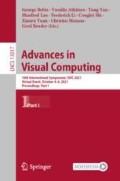Abstract
We compare the perceived naturalness of character animations generated using three interpolation methods: linear Euler, spherical linear quaternion, and spherical spline quaternion. While previous work focused on the mathematical description of these interpolation types, our work studies the perceptual evaluation of animated upper body character gestures generated using these interpolations. Ninety-seven participants watched 12 animation clips of a character performing four different upper body motions: a beat gesture, a deictic gesture, an iconic gesture, and a metaphoric gesture. Three animation clips were generated for each gesture using the three interpolation methods. The participants rated their naturalness on a 5-point Likert scale. The results showed that animations generated using spherical spline quaternion interpolation were perceived as significantly more natural than those generated using the other two interpolation methods. The findings held true for all subjects regardless of gender and animation experience and across all four gestures.
Access this chapter
Tax calculation will be finalised at checkout
Purchases are for personal use only
References
Barr, A.H., Currin, B., Gabriel, S., Hughes, J.F.: Smooth interpolation of orientations with angular velocity constraints using quaternions. Comput. Graph., 8 (1992)
Blake, R., Shiffrar, M.: Perception of human motion. Annual Rev. Psychol. 58(1), 47–73 (2007)
Bloom, C., Blow, J., Muratori, C.: Errors and omissions in marc Alexa’s “Linear Combination of Transformations”, p. 5 (2004)
Chaminade, T., Hodgins, J., Kawato, M.: Anthropomorphism influences perception of computer-animated characters’ actions. Soc. Cogn. Affect. Neurosci. 2(3), 206–216 (2007)
Cheng, J., Zhou, W., Lei, X., Adamo, N., Benes, B.: The effects of body gestures and gender on viewer’s perception of animated pedagogical agent’s emotions. In: Kurosu, M. (ed.) HCII 2020. LNCS, vol. 12182, pp. 169–186. Springer, Cham (2020). https://doi.org/10.1007/978-3-030-49062-1_11
Dam, E.B., Koch, M., Lillholm, M.: Quaternions, interpolation and animation, p. 103 (1998)
Etemad, S.A., Arya, A., Parush, A., DiPaola, S.: Perceptual validity in animation of human motion: Perceptual validity in animation of human motion. Comp. Anim. Virt. Worlds 27(1), 58–71 (2016)
Geier, M.: Quanterion-nursery (2020). https://github.com/mgeier/quaternion-nursery
Heloir, A., Kipp, M.: EMBR: a realtime animation engine for interactive embodied agents, p. 2 (2009)
Horswill, I.D.: Lightweight procedural animation with believable physical interactions. IEEE Trans. Comput. Intell. AI Games 1(1), 39–49 (2009)
Hyde, J., Carter, E.J., Kiesler, S., Hodgins, J.K.: Assessing naturalness and emotional intensity: a perceptual study of animated facial motion, p. 8 (2014)
Jansen, S.E.M., van Welbergen, H.: Methodologies for the user evaluation of the motion of virtual humans. In: Ruttkay, Z., Kipp, M., Nijholt, A., Vilhjálmsson, H.H. (eds.) IVA 2009. LNCS (LNAI), vol. 5773, pp. 125–131. Springer, Heidelberg (2009). https://doi.org/10.1007/978-3-642-04380-2_16
Johansen, R.S.: Automated semi-procedural animation for character locomotion p. 114 (2009)
Krämer, N.C., Karacora, B., Lucas, G., Dehghani, M., Rüther, G., Gratch, J.: Closing the gender gap in STEM with friendly male instructors? On the effects of rapport behavior and gender of a virtual agent in an instructional interaction. Comput. Educat. 99, 1–13 (2016)
Lasseter, J.: Principles of traditional animation applied to 3D computer animation. ACM Comput. Graph. 21(4), 35–44 (1987)
Lawson, A.P., Mayer, R.E., Adamo-Villani, N., Benes, B., Lei, X., Cheng, J.: Do learners recognize and relate to the emotions displayed by virtual instructors? Int. J. Artif. Intell. Educ. 114, 1560–4306 (2021)
Lawson, A.P., Mayer, R.E., Adamo-Villani, N., Benes, B., Lei, X., Cheng, J.: Recognizing the emotional state of human and virtual instructors. Comput. Hum. Behav. 114, 106554 (2021)
Matsiola, M., Dimoulas, C., Veglis, A., Kalliris, G.: Augmenting user interaction experience through embedded multimodal media agents in social networking environments (2005)
Mezger, J., Ilg, W., Giese, M.A.: Trajectory synthesis by hierarchical spatio-temporal correspondence: comparison of different methods. In: Proceedings of the 2nd symposium on Appied perception in graphics and visualization - APGV 2005, p. 25. ACM Press (2005)
Mixamo: X Bot (2008). https://www.mixamo.com/#/?page=3&type=Character
Mori, M.: The Uncanny Valley. In: The uncanny valley, vol. 7(4), pp. 33–35, Energy (1970)
Proffitt, D.R., Gilden, D.L.: Understanding natural dynamics. J. Exp. Psychol. Hum. Percet. Perform. 15(2), 384–393 (1989)
Reitsma, P.S.A., Andrews, J., Pollard, N.S.: Effect of character animacy and preparatory motion on perceptual magnitude of errors in ballistic motion. Comp. Graph. Forum 27(2), 201–210 (2008)
Shoemake, K.: Animating rotation with quaternion curves. SIGGRAPH 1985 19(3) (1985)
Shoemake, K.: Quaternion calculus and fast animation (1987)
So, C.K.F., Baciu, G.: Entropy-based motion extraction for motion capture animation. Comp. Anim. Virt. Worlds 16(3–4), 225–235 (2005)
Van Welbergen, H., Van Basten, B.J.H., Egges, A., Ruttkay, Z.M., Overmars, M.H.: Real time animation of virtual humans: a trade-off between naturalness and control. Comp. Graph. Forum 29(8), 2530–2554 (2010)
van Welbergen, H., Yaghoubzadeh, R., Kopp, S.: AsapRealizer 2.0: the next steps in fluent behavior realization for ECAs. In: Bickmore, T., Marsella, S., Sidner, C. (eds.) IVA 2014. LNCS (LNAI), vol. 8637, pp. 449–462. Springer, Cham (2014). https://doi.org/10.1007/978-3-319-09767-1_56
Vicovaro, M., Hoyet, L., Burigana, L., O’sullivan, C.: Perceptual evaluation of motion editing for realistic throwing animations. ACM Trans. Appl. Percept. 11(2), 1–23 (2014)
Wang, Y., Lang, F., Wang, Z., Xu, B.: Automatic variable-timing animation transition based on hierarchical interpolation method. In: Proceedings of the 10th International Conference on Computer Graphics Theory and Applications, pp. 309–316. SCITEPRESS - Science and and Technology Publications (2015)
Zibrek, K., Hoyet, L., Ruhland, K., McDonnell, R.: Exploring the effect of motion type and emotions on the perception of gender in virtual humans. ACM Trans. Appl. Percept. 12(3), 1–20 (2015)
Acknowledgements
The work reported in the paper is supported in part by NSF–IIS-Cyberlearning & Future Learning Technologies, Award #1821894, Title: Multimodal Affective Pedagogical Agents for Different Types of Learners.
Author information
Authors and Affiliations
Corresponding authors
Editor information
Editors and Affiliations
Rights and permissions
Copyright information
© 2021 Springer Nature Switzerland AG
About this paper
Cite this paper
Lei, X. et al. (2021). Perceived Naturalness of Interpolation Methods for Character Upper Body Animation. In: Bebis, G., et al. Advances in Visual Computing. ISVC 2021. Lecture Notes in Computer Science(), vol 13017. Springer, Cham. https://doi.org/10.1007/978-3-030-90439-5_9
Download citation
DOI: https://doi.org/10.1007/978-3-030-90439-5_9
Published:
Publisher Name: Springer, Cham
Print ISBN: 978-3-030-90438-8
Online ISBN: 978-3-030-90439-5
eBook Packages: Computer ScienceComputer Science (R0)

